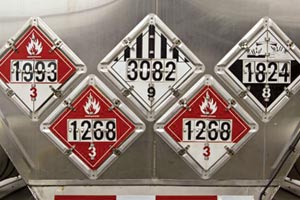Hauling Hazmat Offers Carriers Opportunities but Demands Compliance With Complex Rules

This story appears in the Nov. 7 print edition of Transport Topics.
Without a doubt, hauling hazardous materials can be a headache, according to some for-hire carriers involved in the highly specialized trucking segment.
But the task also represents an opportunity to boost business, as long as a fleet has the right team of experts in place to guarantee that it fully complies with hazardous materials regulations, executives said.
Boyle Transportation, which specializes in hazmat, provides secure freight transportation for customers in defense and life sciences, said Marc Boyle, president of the Billerica, Massachusetts-based company. Most of the hazardous materials the company transports require a hazardous materials safety permit, he said.
For defense customers, the company provides transportation protective services required for shipments of hazardous materials, including explosives and radioactive materials, and classified items, Boyle said. For life sciences, the fleet provides secure, temperature-controlled transportation for products including hazardous materials.
The company’s expertise in hazardous materials is “built on extensive training and a focus on continuous improvement,” Boyle said.
But not all carriers are as rigorous in their hazmat compliance. And with a million hazardous shipments in the United States each day, there’s plenty of opportunity — especially among the smaller fleets with less sophisticated resources — to get it wrong.
A recent case in point is Industrial Transit, a five-truck company out of LaGrange, Georgia. An investigation began after one of the company’s trucks hauling Takata air bag components, which are designated as hazmat, crashed in August in Maverick County, Texas, resulting in a fatality and extensive property damage.
According to an Oct. 9 statement on the crash issued by the Federal Motor Carrier Safety Administration, the driver attempted to take a curve going too fast and crashed into a culvert, resulting in the truck rolling over and catching fire. The fire set off the explosive air bag inflaters, which destroyed a nearby house and garage, and damaged several other homes in the area.
Turning the accident into a tragedy, an occupant in the leveled house was killed, and the team drivers of the truck and another couple in a nearby car were injured.
FMCSA reported serious out-of-compliance violations by the company, including the fact that drivers were on the road without commercial driver licenses and did not have the required hazmat endorsement. The company also failed to provide its hazmat employees with the required training or in-depth security screening, failed to comply with federal safety regulations pertaining to hazmat shipping paper information and failed to have hazmat security or communications plans in place.
“We see both ignorance by the carriers and the reluctance” by shippers to pay a premium for hauling hazmat, said Sonia Irusta, lead hazmat instructor of trucking training for the nonprofit Sustainable Workplace Alliance. “More responsible trucking companies are fully compliant and do their best to keep up with all hazmat regulations,” Irusta said. “Still, too many others get by without complying. You would be surprised how many are out there.”
Lew Grill, president and principal of The Legacy Corp. International, a driver and hazmat training center in Billings, Montana, estimates 85% to 90% of companies do a good job of keeping up with hazmat regulations. It’s the rest of them that are a problem, he said.
Irusta said the process for shipping hazmat should be guided by her acronym, CIPC: classification, identification, packaging and communications. “For a driver to be ready to pick up a load, he has to know what type of hazard it is and the level of danger that makes up the hazmat shipment,” she said, noting the driver must know how the materials are classified.
If a driver sees damaged or inadequate packaging, he knows the load is noncompliant and should refuse it, Irusta said. “But this can be difficult as shippers put on a lot of pressure.” Most often, however, the driver is the one who will get a citation and a black mark on his pre-screening program, the driver’s personal report card, if something goes wrong.
A driver also should be able to understand the bill of lading when arriving to pick up a hazardous shipment, Grill said. For example, an (800) call-in number is required to be on the bills by regulation, he said. “If it is missing or doesn’t connect to an emergency responder team, that’s a violation for the driver — and it’s an easy one to avoid,” he said. “The driver should call and make sure it’s a working number before leaving with the hazardous load.”
“Critical” communication involves placarding, Irusta added, noting that placarding is both the shipper’s and driver’s responsibility. “If a driver fails to placard when required and gets stopped by the Department of Transportation, it is the driver who gets the ticket,” she said.
In addition, the bill of lading showing the classification and identity of the material must be in plain sight, Irusta said, adding that the driver is responsible for keeping shipping documents within reach when wearing a seat belt.
Drivers should be properly trained and must understand they are putting their lives at risk, she said. “The public is also affected when compliance does not take place.”
With about 50% of its freight in the hazmat category, Boyle Transportation takes this responsibility seriously and has the resources to ensure compliance. “Because we’re typically handling truckload quantities that require a hazardous materials safety permit, I would say the shippers we work with are very good at proper documentation,” said Boyle, who serves on committees with the National Defense Transportation Association and American Trucking Associations. “Bills of lading are reviewed by our operations center, and any discrepancies are addressed.”
Winnipeg, Manitoba-based Bison Transport has significant cross-border traffic and must comply with U.S. regulations for hauling hazmat. To accomplish that, the company’s drivers carry FAST (free and secure trade) identity cards.
“A FAST card expedites the border crossing when hauling hazardous materials into the states,” said Garth Pitzel, safety and driver development director. “That means drivers undergo extensive criminal background checks.”
Although all Bison drivers have FAST cards, just a small amount of the freight Bison hauls is hazmat. “Only five out of a hundred vehicles are carrying dangerous goods,” said Pitzel. “A driver could go months before he gets another hazmat load, and then he has to remember everything involved in how to haul and handle this type of freight.”
Bison maintains a core competency in hazmat to guarantee compliance. “Big chemical companies are well-informed,” he said. “The difficulties come from other shippers that don’t have the knowledge, so we have to be the experts. … We’re the final group that has to make sure it’s done right.”
“One of the difficulties for us is the hazmat CSA scores,” Pitzel said, referring to the federal Compliance, Safety, Accountability safety ratings program. “The way it’s calculated takes no account of fleet size, miles run or driver. It has resulted in high scores for us and many other carriers.”
Fleets with less total hazmat freight are at a disadvantage with CSA scoring. “There are far fewer hazmat inspections than others,” Grill said. A company may have only three inspections on record, and if just one is out of compliance, it results in an unsatisfactory score, he said.
“This is where training is the key,” Pitzel added, noting that Bison created hazmat teams “because we realize hazmat is different; it’s not the usual load.”
On the other hand, because hazmat is such a high proportion of Boyle Transportation’s freight, Boyle said he’s happy with how CSA works.
“We are strong supporters of CSA and believe it has made the industry safer,” he said. For shippers, safety performance, especially the Safety Measurement System, “is a critical part of the carrier selection process.”
Bison Transport Inc. ranks No. 65 on the Transport Topics Top 100 list of the largest U.S. and Canadian for-hire carriers.




